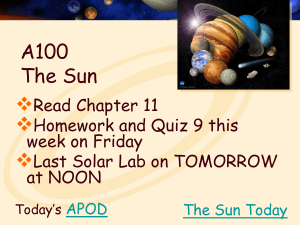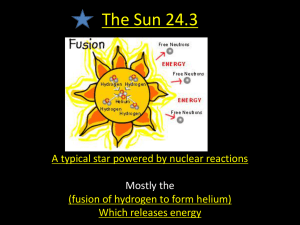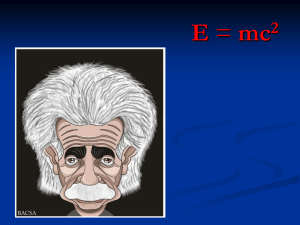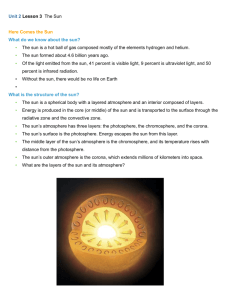The Sun I
advertisement
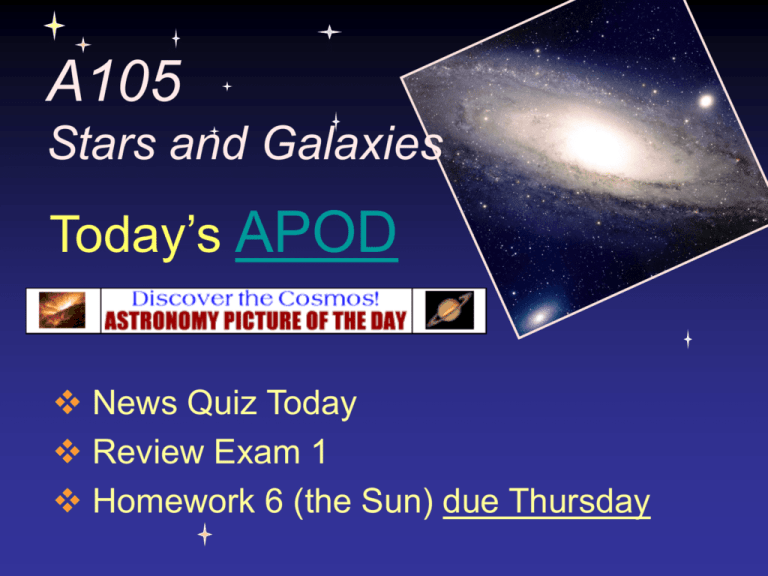
A105 Stars and Galaxies Today’s APOD News Quiz Today Review Exam 1 Homework 6 (the Sun) due Thursday Announcements… • Solar Lab today at 11, tomorrow at 2 PM • Kirkwood Obs. Moon Festival, Oct. 4, 8:30-10:30 • Rooftop Session, Oct. 4, 9:00 • Orionid meteor shower, Oct. 21-22, just before midnight Exam Review • Range of score: 24-76 of 80 questions • Average score: 54/80 NovaSearch I Homework • If you picked a year with just a few observations available, you will need to select another year with more for NS II and NS III! • If the year you selected did not seem to show any blemishes, view some other years to see what they look like. News Quiz • On a piece of paper, list three important ideas from this week’s audio selection • Print your name carefully – if we can’t read your writing, we can post the points to the gradebook! The Sun Today • Image credit: Solar Orbiting Heliospheric Observatory/MDI Basic Facts • radius • • distance • • The Sun 7 x 105 km about 100 x Earth’s radius mass = about 300,000 x Earth’s mass • • • 1 AU, 8 light minutes 1.5 x 108 km about 100 x Sun’s diameter • Temperature • about 6000 Kelvin (10,000 F) at the surface • about 15 million Kelvin inside • Composition • 90% of atoms are hydrogen • 10% of atoms are helium WHY WE STUDY THE SUN Helioseismology With helioseismology, we can measure temperature, pressure and motion inside the Sun from sound waves that traverse the Sun’s interior. Helioseismology Listen to the Sun blue = inward motion red = outward motion The Sun oscillates in complex patterns over the whole interior and surface. The frequency and location of the oscillations give us a detailed picture of the inside of the Sun. Basic Structure INSIDE Core Radiative Zone Convection Zone OUTSIDE Photosphere Chromosphere Corona Solar Wind Conditions inside the Sun Temperature peaks in the core and drops off at the outside edge of the Sun Why does the Sun Shine? • The Sun is a “cooling ember” • The Sun is burning like coal or wood • The Sun is contracting due to gravity NONE OF THESE PRODUCES ENOUGH ENERGY NUCLEAR REACTIONS produce enough energy E = 2 mc - Einstein, 1905 Nuclear Potential Energy (core) Luminosity ~ 10 billion years What produces nuclear energy? Fission: Big nucleus splits into smaller pieces Fusion: Small nuclei stick together to make a bigger one The Sun releases energy by fusing four hydrogen nuclei into one helium nucleus Nuclear fusion requires high temperatures and high density The Sun’s Energy Comes from Nuclear Fusion The Conversion of hydrogen into helium Proton-proton chain fuses hydrogen into helium IN: 4 protons OUT: 4He nucleus 2 gamma rays 2 positrons 2 neutrinos Total mass is 0.7% lower •The missing mass is converted to energy •Rate of nuclear fusion depends on temperature How do we know nuclear reactions are going on in the Sun? •Neutrinos created during fusion fly directly out of the Sun •These neutrinos can be detected on Earth The Sun’s Lifetime Estimating the Sun’s Lifetime • How much fuel does the Sun have? • How fast is that fuel being consumed? • When will it run out? How much fuel? • The Sun “burns” hydrogen to helium in a nuclear reaction 2 E = mc • How many hydrogen atoms in the Sun – 2 x 1033 grams of hydrogen – 6 x 1023 atoms in each gram 12 x 10 56 hydrogen atoms How Much Energy Can the Sun Produce? E= 2 mc • For each helium nucleus created, the Sun produces 5 x 10-12 joules of energy – the Sun can burn half its hydrogen – FOUR hydrogen atoms are needed to make each helium atom ½ x ¼ x 12x1056 x 5x10-12 = 7 x 10 44 joules The Solar Constant 1400 watts = 14 100-watt light bulbs • How Much Energy Each What is a joule? Second? – At the distance of the Earth, the Sun radiates 1400 watts (1400 joules per second) in each square meter on the surface of a sphere with a radius equal to one AU – How many square meters are on that sphere? Each second a 100-watt light bulb produces 100 joules of energy 1 meter Sphere with radius of 1 AU Surface area of a sphere = 4pr2 How many square meters on a sphere with radius one AU? The Sun produces 4 x 1026 watts Area times energy per square meter per second equals total energy output per second Solar Energy How long will the Sun shine??? From the conversion of hydrogen into helium by nuclear reactions… Total energy available = 7 x 1044 joules Radiating energy at 4 x 1026 joules per second Lifetime = 7 x 1044 joules 4 x 1026 joules per second = 2 x 1018 seconds = 6 x 1010 years E = mc2 Solar Energy How long will the Sun shine??? In fact, the Sun will only shine for about 10 billion years, twice its present age. Not all the Sun’s hydrogen is in regions hot enough for hydrogen fusion reactions to occur. We’ll learn more about the future evolution of the Sun as we look more closely at other stars in the Galaxy. E = mc2 How does the energy from fusion get out of the Sun? • Radiation • Convection How does the energy from fusion get out of the Sun? Radiation: In the inner regions of the solar interior, energy gradually leaks upward in form of randomly bouncing electromagnetic waves. Further from the center, the wavelengths of the electromagnetic waves become longer. Energy Transport In the outer regions of the Sun’s interior, energy flows outward by convection; heat is carried upward by bubbling hot gas. The convection zone gives the surface the appearance of boiling liquid Balancing Gravity Gravitational contraction: Provided energy that heated core as Sun was forming Contraction stopped when fusion began Gravitational equilibrium: Energy provided by fusion maintains the pressure Solar Thermostat Decline in core temperature causes fusion rate to drop, so core contracts and heats up Rise in core temperature causes fusion rate to rise, so core expands and cools down Summary: • Why was the Sun’s energy source a major mystery? – Chemical and gravitational energy sources could not explain how the Sun could sustain its luminosity for more than about 25 million years • Why does the Sun shine? – The Sun shines because gravitational equilibrium keeps its core hot and dense enough to release energy through nuclear fusion. The Budget of Solar Radiation What happens to sunlight that falls on the Earth? percent Reflected back out to space 35% Absorbed by atmosphere 18% Scattered to the Earth from blue sky 10% Scattered to the Earth from clouds 14% Hits the Earth's surface directly 23% 100% Recall the structure of the Sun… Corona The Sun’s Atmosphere: Photosphere, Chromosphere, Corona, Solar Wind The Sun! Units 49, 50, 52 Homework 6 Due THURS. SOLAR LAB TODAY AT 11:00, TOMORROW AT 2:00
